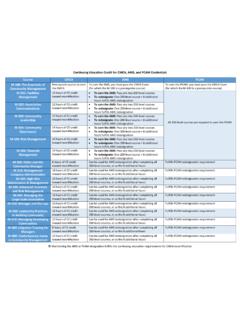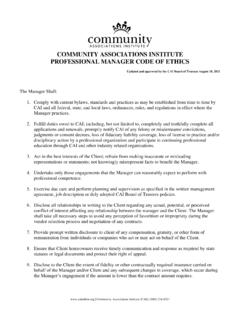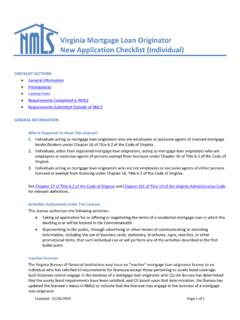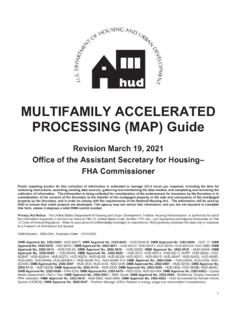Transcription of THE BOARD MEMBER TOOL KIT
1 THIRD EDITION6402 Arlington Blvd., Suite 500 Falls Church, VA BOARD MEMBER TOOL KITThe BOARD MEMBER Tool KitA guide FOR COMMUNITY ASSOCIATION VOLUNTEER LEADERSTHIRD EDITIONThe BOARD MEMBER Tool Kit, 3rd. 978-159618-071-0 2014 Community Associations InstituteAll rights reserved. No part of this document may be reproduced, stored in a retrieval system, or transmitted, in any form or by any means, electronic, mechanical, audio, visual, or otherwise, without the prior written consent of the publisher. Inquiries should be directed to Community Associations Associations Institute6402 Arlington Blvd., Suite 500 Falls Church, VA 22042 This publication is designed to provide accurate and authoritative information in regard to the subject matter covered. It is published with the understanding that the publisher is not engaged in rendering legal, accounting, or other professional services.
2 If legal advice or other expert assistance is required, the services of a competent professional should be sought. From a Declaration of Principles, jointly adopted by a Committee of the American Bar Association and a Committee of PublishersPrinted in the United States of AmericaABOUT CAIC ommunity Associations Institute (CAI) is a national organization dedicated to fostering vibrant, competent, harmonious community associations. For more than 30 years, CAI has been the leader in providing education and resources to the volunteer homeown-ers who govern community associations and the professionals who support them. Our members include community association volunteer leaders, professional managers, com-munity management firms, and other professionals and companies that provide products and services to recognizes that volunteers ultimately are responsible for building community, meet-ing the expectations of neighbors and protecting property values.
3 This is why CAI is committed to providing the information and support homeowner leaders need to be more effective, efficient and respected EditionEllen Hirsch de Haan, Grucza, cmca, ams, pcamPearline Atkinson-Stewart3rd EditionSharon BrimerJulie Hardy CramerDavid HoltRobert RiddickRobert RothwellIrene SoskinContentsINTRODUCTION 1. Governing Documents 2. The Role of the BOARD 3. The Role of the President 4. The Role of the Secretary 5. The Role of the Treasurer 6. Working with a Professional Manager 7. Working with Professional Partners 8. The Importance of Meetings 9. Electing BOARD Members 10. Finding Volunteers 11. Finances 12. Reserves 13. Selecting Contractors 14. Communicating with Residents 15. RulesAPPENDIX A: How to Get the Most from Your CAI MembershipAPPENDIX B: Community Association FundamentalsAPPENDIX C: Rights and Responsibilities for Better CommunitiesAPPENDIX D: Model Code of Ethics for Community Association BOARD MembersAPPENDIX E: Governance GuidelinesIntroductionW elcome to CAI.
4 Whether you manage the associa-tion yourself or have the assistance of professional management; whether you re on the BOARD of a condominium or homeowner association or a cooperative; and whether your association comprises just a handful of homes or thousands of homes in a large-scale community joining CAI can do more to ensure your success than just about anything else you can do. DID YOU KNOW?n You re part of the leadership team of a corporation. Your association is a corporation; and, although you re not running Microsoft or AT&T, you re still a corporate BOARD MEMBER , responsible for running a business. Your investors are your association members, and you re responsible for maximizing the return on their investment their You re an elected official. Your association likely provides some services that traditionally were provided by local government.
5 That makes you similar to a town council MEMBER (or the mayor, if you re the president), responsible for ensuring that services are provided and that rules are appropriate and fairly applied. Your citizens are again your association members, and you re responsible for maintaining and enhancing their quality of life. vi The BOARD MEMBER Tool Kit INTRODUCTIONn You re a leader. Your association is a neighborhood like a family. That makes you a parent, cheerleader, role model, social director in short, a community builder. That s a lot of responsibility, and we re here to support you. Our mission is to help you not only succeed, but to achieve suc-cess with a minimum amount of anxiety. Hopefully, we can even help you enjoy the experience. That s why we re providing this overview of what you need to know. It s just the beginning; and we trust it will lead you to the information, tools, and resources you need to be a successful and respected sure to take advantage of all that CAI has to offer.
6 We know we have a lot awaiting you, so we ve tried to catalog and simplify those offerings in Appendix A: How to Get the Most from Your CAI Membership. Most of the sample forms, checklists and notices in this Tool Kit are available to CAI members at There you can download the documents and, in most cases, customize them for your association. See Appendix A for more information about accessing these services online. This Tool Kit is just one of the resources that can help you be a successful and respected leader. If you can t find what you need in this guide , call us toll-free at (888) 224-4321 (M F, 9 6:30 ET) and we ll be happy to help DocumentsF ew people like fine print or red tape, but there are several important documents BOARD members need to be familiar and comfortable with. Collectively, they re called governing documents.
7 Depending on the type of as-sociation you live in, individual documents will differ. Each is a very useful tool that will provide specific guidance and requirements to which the association must adhere. WHY ARE GOVERNING DOCUMENTS IMPORTANT?n They give boards the authority to govern by providing for the operation and regulation of the They provide guidance and protect They protect association members by spelling out their rights and responsibilities. n They are supported by local ordinances, state statutes, and federal regulations. Governing documents will provide the structure within which the BOARD can work effectively, they ll guide BOARD decision making, and support association greatest value, however, lies in the fact that they are agreed to by all owners when they purchase a home in the association. The governing documents create an objective and consistent framework establishing uniform rights, re-sponsibilities and expectations thereby providing a positive common interest community experience for :2 The BOARD MEMBER Tool Kit GOVERNING DOCUMENTSC ommunity association governing documents typically include several items in descending order of Declaration or master deed, including Covenants, Conditions & Restrictions, or CC&Rs (in condominiums and planned communities)n Proprietary lease, master lease, or occupancy agreement (in cooperatives)n Articles of Incorporation n Bylawsn Rules and RegulationsTHE DECLARATIONThe Declaration (or Master Deed) contains the CC&Rs that regu-late resident behavior.
8 They bind all the owners to the association, establish association responsibilities, and define owners rights and obligations. (In cooperatives, this document is called the pro-prietary lease or occupancy agreement.)ARTICLES OF INCORPORATIONA rticles of Incorporation initially create the corporation under state law and define the association s basic purposes and powers. They may specify such things as the number of directors, terms of of-fice, and other specifics about how the BOARD functions. (In some states, condominium and planned community associations are not legally required to incorporate. If you live in one of these states you probably have articles of association.)BYLAWSB ylaws contain provisions concerning actual association operations, such as meetings, procedures for electing the BOARD members and officers, and general duties of the BOARD .
9 Sometimes the bylaws cover the same topics as the DOCUMENTS The BOARD MEMBER Tool Kit 1:3!RULES AND RESOLUTIONSB oards adopt rules and regulations. They must be consistent with the declaration or proprietary lease, the bylaws, and state law. Rules are usually recorded at a BOARD meeting in the form of a motion called a policy resolution. Making and enforcing rules are important responsibilities for boards that must be undertak-en with care. See section 15 for more addition to policy resolu-tions, boards will also adopt administrative, special, and general resolutions. These res-olutions specify how the asso-ciation should operate. BOARD members should familiarize themselves with all association resolutions along with the other governing documents. TOOL : See the Sample Resolutions at the end of this distinction between areas that are owned separately and areas that are owned in common is the cause of much misunderstanding in community associations.
10 It s important to understand the differ-ences based on the information in the governing governing documents must not conflict with federal regulations, state statutes, or local ordinances. It s important to have your association governing documents reviewed by the asso-ciation attorney to ensure that they do not Four Types of Resolutions1. Policy resolutions affect owners rights and Administrative resolutions address the internal operations of the commu-nity association. 3. Special resolutions record BOARD decisions that apply a policy to an individual General resolutions record BOARD decisions regarding routine :4 The BOARD MEMBER Tool Kit GOVERNING DOCUMENTSC ommunity Association Governance GuidelinesThe Community Association Governance Guidelines are offered by CAI to help BOARD members and other community leaders create and sustain more effective, harmonious communities.











